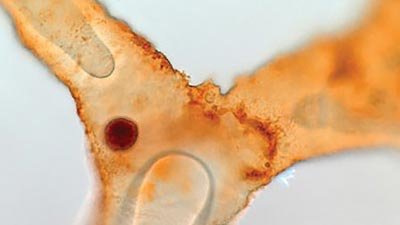Collagen Coils
Collagen coils kept fossilized fragments intact.
News Source
Ever since evolutionist Mary Schweitzer’s discovery of collagen in fossilized dinosaur bones, controversy has raged over the authenticity of her findings. Her claims are compatible with a biblical young earth view, but the secular world has been squirming. Many scientists, unable to believe soft tissues could survive for millions of years, have insisted the tissues were contaminants.
“The first and largest hurdle has been to convince people that this stuff is real,” Schweitzer says. “This paper is a step in that direction.”
A team led by Schweitzer and biochemist James San Antonio analyzed eleven fragments of dinosaur collagen and compared the molecular structure to that of collagen from rats and humans.1 Collagen is made of three chains of amino acids coiled and bundled together in groups of five. Thousands of those bundles are twisted into each fibril. The interactions of the amino acids help stabilize this rope-like structure.
Since all fragments corresponded to those parts of collagen best-protected from the environment, the team is hopeful the collagen’s authenticity will be accepted.
The team found that the molecular structure of all eleven fragments corresponded to those found in the innermost, protected part of collagen fibers. Furthermore, the amino acids in the surviving segments were those which best resist degradation by enzymes and water. Since all fragments corresponded to those parts of collagen best-protected from the environment, the team is hopeful the collagen’s authenticity will be accepted.
“If any collagen could survive millions of years, it would not be a random assortment but the sheltered kinds of molecules that were observed,” says co-author James Orgel.2
This year has already produced additional confirmation that proteins can survive within fossils. Collagen was found in a marine fossil by a Swedish group. Keratin was confirmed to have survived in fossilized lizard skin from the Green River formation.3 In both cases, extensive tests demonstrated that the proteins really belonged to the fossilized animals and were not contaminants. Thus, evidence is mounting that some fossils still contain original organic components.
San Antonio and Schweitzer’s results do show a mechanism by which fragile protein molecules could find safe harbor over time. But for how long? Nothing has actually demonstrated how long those protein molecules have been preserved. We would contend based on biblical history that they have been preserved only a few thousand years.
Further Reading
- Get Answers: Fossils
For More Information: Get Answers
Remember, if you see a news story that might merit some attention, let us know about it! (Note: if the story originates from the Associated Press, FOX News, MSNBC, the New York Times, or another major national media outlet, we will most likely have already heard about it.) And thanks to all of our readers who have submitted great news tips to us. If you didn’t catch all the latest News to Know, why not take a look to see what you’ve missed?
(Please note that links will take you directly to the source. Answers in Genesis is not responsible for content on the websites to which we refer. For more information, please see our Privacy Policy.)
Footnotes
- Rachel Ehrenberg, “Dino Proteins Could Have Been Sheltered,” ScienceNews, June 15, 2011, https://www.sciencenews.org/article/dino-proteins-could-have-been-sheltered.
- Ibid.
- N. P. Edwards et al., “Infrared Mapping Resolves Soft Tissue Preservation in 50 Million Year-old Reptile Skin,” Proc. R. Soc. B 278, no. 1722: doi:10.1098/rspb.2011.0135.
Recommended Resources

Answers in Genesis is an apologetics ministry, dedicated to helping Christians defend their faith and proclaim the good news of Jesus Christ.
- Customer Service 800.778.3390
- Available Monday–Friday | 9 AM–5 PM ET
- © 2025 Answers in Genesis





